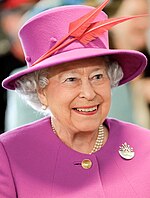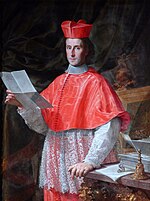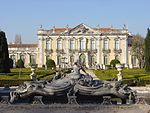Portal:Monarchy/Featured article
Featured article 1
Portal:Monarchy/Featured article/1
Thefortress, during its long and often dramatic history it has been bombarded and besieged by many foreign powers. Since the end of the 13th century, it has been the stronghold and home of the Grimaldi family who first captured it in 1297. The Grimaldis' power was often derived from fragile agreements with their larger and stronger neighbours. Thus while the sovereigns of Europe were building luxurious, modern Renaissance and Baroque palaces, politics and common sense demanded that the palace of the Monaco rulers be fortified. The Grimaldis' occupation of their palace is also unusual because, unlike other European ruling families, the absence of alternative palaces and land shortages have resulted in their use of the same residence for more than seven centuries. During the 19th and early 20th centuries, the palace and its owners became symbols of the slightly risqué glamour and decadence that was associated with Monte Carlo and the French Riviera. Glamour and theatricality became reality when the American film star Grace Kelly became chatelaine to the palace in 1956. In the 21st century, the palace remains the residence of the current
Prince of Monaco.
Featured article 2
Portal:Monarchy/Featured article/2
TheNorman conquest of England and the English monarchy passed to the Normans' victorious leader, William the Conqueror
, and his descendants.
Featured article 3
Portal:Monarchy/Featured article/3
TheSkalmantas, an otherwise unknown historical figure, was Gediminas' grandfather or father, and could be considered the dynasty's founder. Because none of his brothers or sisters had known heirs, Gediminas, who sired at least twelve children, had the advantage in establishing sovereignty over his siblings. Known for his diplomatic skills, Gediminas arranged his children's marriages to suit the goals of his foreign policy: his sons consolidated Lithuanian power within the Grand Duchy of Lithuania, while his daughters established or strengthened alliances with the rulers of areas in modern-day Russia, Ukraine, and Poland. Gediminas' many grandchildren and their descendants engaged in power struggles that continued well into the 15th century. Gediminas' grandchildren converted Lithuania to Christianity and inaugurated the first personal union with Poland. The dynasty came to an end in 1572, when Sigismund II Augustus
died without producing a male heir.
Featured article 4
Portal:Monarchy/Featured article/4
Queen Elizabeth II (pictured at the 2005 service) almost always attends, and the service is held in a different church (usually a cathedral
) every year. Maundy money is struck in denominations of one penny, two pence, three pence, and four pence. In most years there are fewer than 2,000 complete sets; they are highly sought after by collectors.
Featured article 5
Portal:Monarchy/Featured article/5
state dinner at the White House.Kalākaua met with heads of state in Asia, the Mideast and Europe, to encourage an influx of sugar plantation labor in family groups, as well as unmarried women as potential brides for Hawaii's existing contract laborers. While in Asia, he tried to forestall American ambitions by offering a plan to Emperor Meiji for putting Hawaii under the protection of the Empire of Japan with an arranged marriage between his niece Kaʻiulani and a Japanese prince. On his visit to Portugal, he negotiated a treaty of friendship and commerce with Hawaii that would provide a legal framework for the emigration of Portuguese laborers to Hawaii. The King had an audience in Rome with Pope Leo XIII and met with many of the crowned heads of Europe. Britain's Queen Victoria
and the splendor of her royal life impressed him more than any other monarchy; having been greatly affected by the ornate trappings of European sovereigns, he would soon have Hawaii's monarchy mirror that grandeur.
Featured article 6
Featured article 7
Portal:Monarchy/Featured article/7
Atemporal power of popes decreased in the 17th and 18th centuries. Notable cardinal-nephews include fourteen popes—John XIX, Benedict IX, Anastasius IV, Gregory IX, Alexander IV, Adrian V, Gregory XI, Boniface IX, Eugene IV, Paul II, Alexander VI, Pius III, Julius II, and Clement VII—and two saints—Charles Borromeo and Anselm of Lucca
.
Featured article 8
Portal:Monarchy/Featured article/8
scholar-officials. The military also provided a means for advancement in Song society for those who became officers, even though soldiers were not highly-respected members of society. Although certain domestic and familial duties were expected of women in Song society, they nonetheless enjoyed a wide range of social and legal rights in an otherwise patriarchal society. Women's improved rights to property came gradually with the increasing value of dowries offered by brides' families. Daoism and Buddhism were the dominant religions of China in the Song era, the latter deeply impacting many beliefs and principles of Neo-Confucianism throughout the dynasty. The Song justice system was maintained by policing sheriffs, investigators, official coroners, and exam-drafted officials who acted as magistrates
.
Featured article 9
Portal:Monarchy/Featured article/9
Pope Paul III and His Grandsons is an oil on canvas painting by Titian, housed in the Museo di Capodimonte, Naples. It was commissioned by the Farnese family and painted during Titian's visit to Rome between autumn 1545 and June 1546. It depicts the thorny relationship between Pope Paul III, born Alessandro Farnese, and two of his grandsons, Ottavio and Alessandro. The painting explores the effects of ageing and the manoeuvring behind succession; Paul was at the time in his late seventies and operating within an uncertain political climate as Charles V came into ascendancy. Paul was not a religious man; he viewed the papacy as a means to consolidate his family's position. He appointed Alessandro as cardinal against accusations of nepotism, fathered a number of illegitimate children and spent large sums of church money collecting art. Titian abandoned the commission before completion, and for the next 100 years the painting languished unframed in a Farnese cellar. It ranks as one of Titian's most penetrating works. The panel contains subtle indications of the contradictions in the character of the Pope, and captures the complex psychological dynamic between the three men.
Featured article 10
Portal:Monarchy/Featured article/10
TheAjuda Palace in 1794, Queluz Palace became the official residence of the Portuguese prince regent, John VI, and his family and remained so until the Royal Family fled to Brazil in 1807 following the French invasion of Portugal. Work on the palace began in 1747 under the architect Mateus Vicente de Oliveira. Despite being far smaller, the palace is often referred to as the Portuguese Versailles
. From 1826, the palace slowly fell from favour with the Portuguese sovereigns. In 1908, it became the property of the state. Following a serious fire in 1934, which gutted the interior, the palace was extensively restored, and today is open to the public as a major tourist attraction.
Featured article 11
Featured article 12
Featured article 13
Featured article 14
Featured article 15
Usage
The layout design for these subpages is at Portal:Monarchy/Featured article/Layout.
- Add a new Featured article to the next available subpage.
- Update "max=" to new total for its {{Random portal component}} on the main page.
Additions
Feel free to add royalty related articles Featured articles to the above list.









